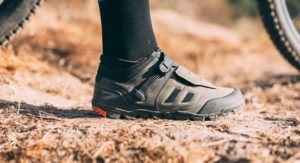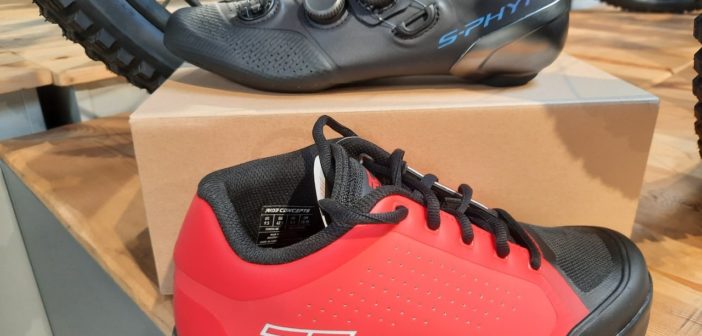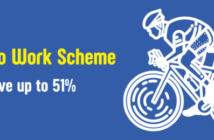Whether you are cycling on or off road, the humble cycling shoe forms a key part of your cycling wardrobe. You can cycle in a pair of runners, but dedicated cycling shoes will be more efficient and comfortable if you are riding any significant distance. Cycling shoes along with clipless pedals allow you to transfer power and keep your feet in the optimum position in terms of ergonomics.
Cycling shoes are generally unisex, however women specific shoes are available. Women’s specific shoes have a narrower heel and wider foot. A wide fit shoe is available in some of the Shimano shoe models.

Road Cycling Shoes
Road shoes will have a very stiff sole, typically made from nylon, composite or carbon fibre. They contain mesh panels to help keep your feet cool in the summer and are usually tightened by Velcro straps, laces or a BOA locking system. The sole purpose (pardon the pun) of a cycling shoe is to get the maximum amount of your power through to the pedal to propel you forward. An entry level road shoe usually starts around €60-€90 and can go to as much as €450. Carbon sole shoes start from approximately, €200 and the stiffer sole means less flexing allowing more power being transferred to the pedal. The more expensive the shoe is, the lighter it will be, but this is something most cyclists shouldn’t worry about.
Our selction of road shoes can be found HERE

Mountain Bike/ Commuter Shoe
They are a lot less rigid than their road going cousins and, in some cases, look more like a normal runner. They will have a more traditional sole with the cleat sunk into the shoe, making them easier to walk around in when you are off the bike. If the thought of clipping in and out doesn’t appeal to you, there are flat shoes that specifically designed for cyclists. Entry level shoes will start from around €80 and can be as much as €300. The difference between an entry level shoe and the high end one, will be the sole is usually made from carbon fibre and the shoe will be fastened using a BOA system.
Our range of MTB & Commuter shoes can be found HERE

- Overcome the fear. The biggest reason why people don’t convert to cycling shoes, is the fear of being unable to unclip and falling off. The benefits one will gain from using cycling shoes far out way the fear. To overcome the fear, is quite simple, practice. Practice unclipping with one hand against a wall, or beside something soft like grass. After a few goes, you’ll start wondering why you hadn’t converted to cycling shoes earlier.
- Always check if your shoes are compatible with your desired cleats. Most shoe and cleat combination work, but there is the odd exception. The side of the shoe box is your best friend as this will tell you which cleats the shoe is compatible with.
- When choosing the shoe, go for a size slightly bigger than your normal shoe. You must remember your cycling shoe, will need to accommodate thick winter socks and your feet sweat and swell during the summer months. However, the shoe should not be so big that your heel comes out when walking.
- Ventilation: Always check the level of ventilation the shoe offers. Some shoes especially winter shoes are designed to keep your feet warm and water out, so ventilation wasn’t a concern when it came to design. Try and match the level of ventilation you require with the weather/climate you’ll be cycling in.
- Cleaning your cycling shoes is easy. A damp cloth will always help get rid of the dirt, but if the dirt is more stubborn, hot soapy water (washing up liquid) and a soft brush should do the trick. Don’t be afraid to submerge the shoes in the soapy water.




